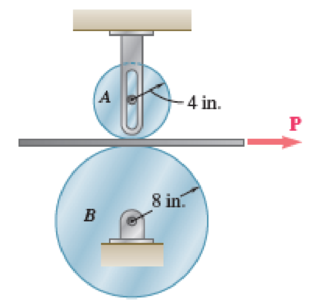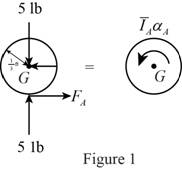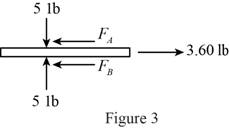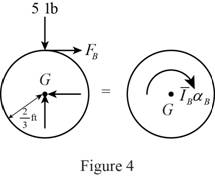
Concept explainers
A belt of negligible mass passes between cylinders A and B and is pulled to the right with a force P. Cylinders A and B weigh, respectively, 5 and 20 lb. The shaft of cylinder A is free to slide in a vertical slot and the coefficients of friction between the belt and each of the cylinders are μs = 0.50 and μk = 0.40. For P = 3.6 lb, determine (a) whether slipping occurs between the belt and either cylinder, (b) the angular acceleration of each cylinder.

Fig. P16.39
(a)
Find whether slipping occurs between the belt and either cylinder.
Explanation of Solution
The force pulled between cylinders A and B (P) is
The weight of the cylinder A
The weight of the cylinder B
The coefficient of the static friction
The coefficient of the kinetic friction
The radius of the cylinder A
The radius of the cylinder B
Calculation:
Consider the acceleration due to gravity (g) as
Convert the unit of the radius of the cylinder A
Convert the unit of the radius of the cylinder B
Consider that no slipping occurs.
Calculate the acceleration of the belt
Calculate the mass of the cylinder A
Substitute
Calculate the mass of the cylinder B
Substitute
Calculate the mass moment of inertia of the cylinder A
Substitute
Calculate the mass moment of inertia of the cylinder B
Substitute
Show the free body diagram of the cylinder A as in Figure 1.

Here,
Refer to Figure 1.
Calculate the moment about point G by applying the equation of equilibrium:
Substitute
Show the free body diagram of the cylinder B as in Figure 2.

Here,
Refer to Figure 2.
Calculate the moment about point G by applying the equation of equilibrium:
Substitute
Show the free body diagram of the belt as in Figure 3.

Refer to Figure 3.
Calculate the horizontal forces by applying the equation of equilibrium:
Sum of horizontal forces is equal to 0.
Calculate the angular acceleration of the cylinder A
Substitute
Calculate the horizontal force of the cylinder A
Substitute
Calculate the horizontal force of the cylinder B
Substitute
Calculate the magnitude of the friction force
Substitute
The horizontal force of the cylinder B is greater than the magnitude of the friction force
Therefore, the slipping occurs between cylinder B and the belt and the slipping not occur between cylinder A and the belt.
(b)
Find the angular acceleration of each cylinder
Answer to Problem 16.39P
The angular acceleration of each cylinder
Explanation of Solution
The force pulled between cylinders A and B (P) is
The weight of the cylinder A
The weight of the cylinder B
The coefficient of the static friction
The coefficient of the kinetic friction
The radius of the cylinder A
The radius of the cylinder B
Calculation:
Refer the part (a).
Consider the slipping occurs at cylinder B.
Therefore, the angular acceleration of the cylinder B is
Calculate the horizontal force of the cylinder B
Substitute
Show the free body diagram of the cylinder B as in Figure 4.

Here,
Refer to Figure 4.
Calculate the angular acceleration of the cylinder B
Calculate the moment about point G by applying the equation of equilibrium:
Substitute
Calculate the horizontal force of the cylinder A
Substitute
The horizontal force of the cylinder A is less than the force of the cylinder B due to the static friction
There is no slipping between the cylinder A and the belt.
Calculate the angular acceleration of the cylinder A
Substitute
Hence, the angular acceleration of each cylinder
Want to see more full solutions like this?
Chapter 16 Solutions
Vector Mechanics for Engineers: Statics and Dynamics
Additional Engineering Textbook Solutions
Vector Mechanics for Engineers: Dynamics
Thinking Like an Engineer: An Active Learning Approach (4th Edition)
Introduction to Heat Transfer
Introduction To Finite Element Analysis And Design
Heating Ventilating and Air Conditioning: Analysis and Design
Fox and McDonald's Introduction to Fluid Mechanics
- A 16-lb spool is at rest on an inclined surface. Around its center a cable is wound which travels with the same inclination of the ramp, passes through a frictionless pulley, and is attached to a block B at its other end.The coefficient of static friction between block B and the floor is 0.25. For the position shown, with the given value of α, determine: R (in) = 11,1 in r (in) = 7 in α (°) = 16° 1. The minimum coefficient of static friction that must exist between the reel and the floor of the ramp, so that the reel does NOT slide on the ramp (does not slip). 2.The minimum weight that block B must have for the reel to NOT roll down the ramp dragging block B. Do not allow for the possibility of the block turning or tipping over.arrow_forwardKnowing that the coefficient of static friction between the tires and the road is 0.80 for the car as shown in figure 2. At this car, suddenly brakes are applied when it was moving with velocity of 360 inch/sec and it skidded to rest in 240 inch. Determine the magnitude of the normal reaction and of the friction force in the terms of W(weight) at each wheel as the car skidded to rest. { Use m=w/g, for the mass of the car if required, where g=386.09inch/s2.}arrow_forwardTwo 8-kg blocks A and B resting on shelves are connected by a rod of negligible mass. Knowing that the magnitude of a horizontal force P applied at C is slowly increased from zero, determine the value of P for which motion occurs and what that motion is when the coefficient of static friction between all surfaces is (a) μs= 0.40, (b) μs= 0.50.arrow_forward
- Knowing that the coefficient of static friction between the tires and the road is 0.8 for the automobile (m=1050 kg) shown, determine 1- normal reaction at front wheels (N), the car is assumed front wheel drive. 2- normal reaction at rear wheels (N), the car is assumed front wheel drive. 3- maximum acceleration (m/s2), the car is assumed front wheel drive.arrow_forwardA 50-lb electric floor polisher is operated on a surface for which the coefficient of kinetic friction is 0.25. Assuming that the normal force per unit area between the disk and the floor is uniformly distributed, determine the magnitude Q of the horizontal forces required to prevent motion of the machine.arrow_forwardA 130-lb crate is being transported by a 175-lb hand- truck cart along the frictionless floor. The coefficients of friction between the cart and the box are μ = 0.20 and Mk = 0.15. If a force P = 45 lb is applied as shown, P determine the smallest ratio d/b for which the box will tip before it slides. Neglect the mass of the wheels of the cart.arrow_forward
- Knowing that the coefficient of static friction between the tires and the road is 0.80 for the car as shown in figure 2. At this car, suddenly brakes are applied when it was moving with velocity of 360 inch/sec and it skidded to rest in 240 inch. The mass of the car is 300 pounds. Determine the magnitude of the normal reaction and of the friction force at each wheel as the car skidded to rest.arrow_forwardKnowing that the coefficient of static friction between the tires and the road is 0.8 for the automobile (m=1050 kg) shown, determine 1-normal reaction at front wheel (N), the car is assumed rear wheel drive. 2- normal reaction at rear wheel (N), the car is assumed rear wheel drive. 3- maximum acceleration (m/s2), the car is assumed rear wheel drive.arrow_forwardA tractor-trailer rig with a 2000-kg tractor, a 4500-kg trailer, and a 3600-kg trailer is traveling on a level road at 90 km/h. The brakes on the rear trailer fail, and the antiskid system of the tractor and front trailer provide the largest possible force that will not cause the wheels to slide. Knowing that the coefficient of static friction is 0.75, determine (a) the shortest time for the rig to a come to a stop, (b) the force in the coupling between the two trailers during that time. Assume that the force exerted by the coupling on each of the two trailers is horizontal.arrow_forward
- A small 250-g collar C can slide on a semicircular rod which is made to rotate about the vertical AB at a constant rate of 7.5 rad/s. Knowing that the coefficients of friction are μs = 0.25 and μk = 0.20, indicate whether the collar will slide on the rod if it is released in the position corresponding to (a) 0= 75°, (b) 0 = 40°. Also, determine the magnitude and direction of the friction force exerted on the collar immediately after release.arrow_forwardThe coefficients of friction are μs = 0.4 between all surfaces of contact. Determine the force P for which motion of the blocks is impending, use g = 9.81 m/s^2 and neglect the friction in pulleys. The coefficients of friction are μs = 0.4 between all surfaces of contact. Determine the tension on the cable for which motion of the blocks is impending, use g = 9.81 m/s^2 and neglect the friction in pulleys.arrow_forwardA cable is placed around three parallel pipes. Two of the pipes are fixed and do not rotate; the third pipe is slowly rotated. Knowing that the coefficients of friction are μs= 0.25 and μk= 0.20, determine the largest weight W that can be raised (a) if only pipe A is rotated counterclockwise, (b) if only pipe C is rotated clockwise.arrow_forward
 Elements Of ElectromagneticsMechanical EngineeringISBN:9780190698614Author:Sadiku, Matthew N. O.Publisher:Oxford University Press
Elements Of ElectromagneticsMechanical EngineeringISBN:9780190698614Author:Sadiku, Matthew N. O.Publisher:Oxford University Press Mechanics of Materials (10th Edition)Mechanical EngineeringISBN:9780134319650Author:Russell C. HibbelerPublisher:PEARSON
Mechanics of Materials (10th Edition)Mechanical EngineeringISBN:9780134319650Author:Russell C. HibbelerPublisher:PEARSON Thermodynamics: An Engineering ApproachMechanical EngineeringISBN:9781259822674Author:Yunus A. Cengel Dr., Michael A. BolesPublisher:McGraw-Hill Education
Thermodynamics: An Engineering ApproachMechanical EngineeringISBN:9781259822674Author:Yunus A. Cengel Dr., Michael A. BolesPublisher:McGraw-Hill Education Control Systems EngineeringMechanical EngineeringISBN:9781118170519Author:Norman S. NisePublisher:WILEY
Control Systems EngineeringMechanical EngineeringISBN:9781118170519Author:Norman S. NisePublisher:WILEY Mechanics of Materials (MindTap Course List)Mechanical EngineeringISBN:9781337093347Author:Barry J. Goodno, James M. GerePublisher:Cengage Learning
Mechanics of Materials (MindTap Course List)Mechanical EngineeringISBN:9781337093347Author:Barry J. Goodno, James M. GerePublisher:Cengage Learning Engineering Mechanics: StaticsMechanical EngineeringISBN:9781118807330Author:James L. Meriam, L. G. Kraige, J. N. BoltonPublisher:WILEY
Engineering Mechanics: StaticsMechanical EngineeringISBN:9781118807330Author:James L. Meriam, L. G. Kraige, J. N. BoltonPublisher:WILEY





